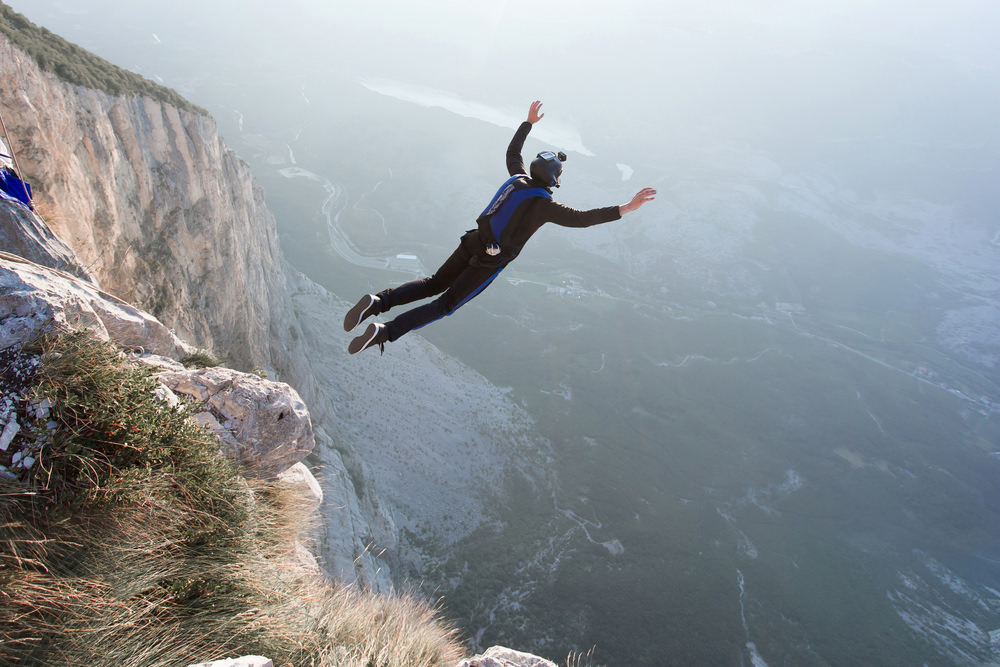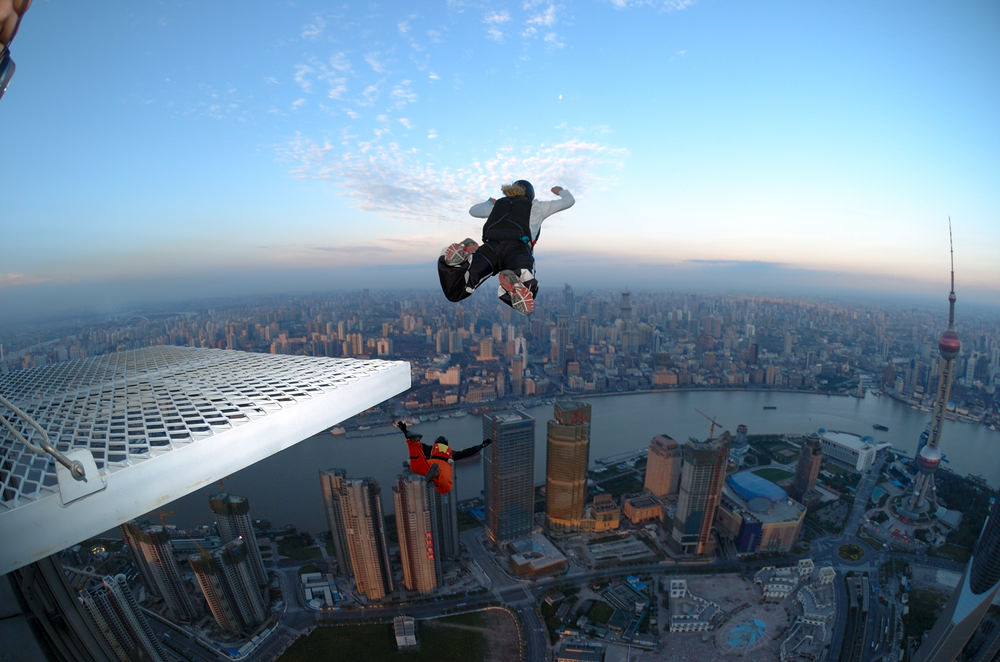Become a BASE Jumper: Step-by-Step Guide
Skydiving
Posted by: Start Skydiving
1 year ago
Just like there are additional requirements to learn how to become a wingsuit skydiver, there are specific prerequisites to learn how to become a BASE jumper. And once you have completed both, you can combine the two for the ultimate adventure and extreme sport! But first, let’s figure out what is required to become a BASE jumper and talk about the differences between skydiving vs BASE jumping.
What is BASE Jumping?
BASE jumping is an activity that is similar to skydiving in the sense that you use a parachute to land – except instead of jumping out of an aircraft, the BASE jumper jumps from objects. You may be surprised to find out that – just like ‘SCUBA’ – ‘BASE’ is an acronym. BASE stands for:
- Building
- Antenna (tower)
- Span (bridge)
- Earth (cliff)
These are the four primary types of objects a BASE jumper can jump from. In some cases, BASE jumpers will even free solo (or climb) up to the jump site of tall structures or mountains all while carrying all of their BASE jumping equipment – this is called free BASE jumping.

BASE Jumping vs Skydiving
The basics of BASE jumping and skydiving seem pretty similar at first glance – jump, pull a parachute, and land. However, they are different when it comes to the type of equipment used, the exit altitude, and the landing areas – so much so that they are considered entirely different sports.
Would we say that skydiving is better than BASE jumping? Not necessarily. Both sports have their pros and cons and can be enjoyed for a plethora of reasons that are all unique to the individual. Here are the biggest differences between skydiving and BASE jumping:
1. Equipment
In skydiving rigs, there are two parachutes: a main parachute that is deployed initially, and a reserve parachute that is deployed in the case of a main parachute malfunction. Whereas, BASE jumping parachutes are a single-parachute system – which means BASE jumpers do not have a backup parachute. Consequently, the containers for BASE jumping tend to be much smaller in size than a skydiving container.
2. Altitude
Most full-altitude skydives are performed between 8,000 and 14,000 feet, and usually never below 2,000 feet even for highly experienced skydivers. Whereas, BASE jumps can be performed anywhere from 300 to 1,000 feet. These extremely low altitudes are the reason why there isn’t a reserve parachute in the BASE rig – there simply isn’t enough time to perform the necessary emergency procedures to deploy a second, reserve parachute.
3. Landing Area
Dropzones are areas where skydives are performed on the norm, therefore, they usually are equipped with well-manicured lawns free of debris and plenty of space for landing. BASE jumps are usually performed in natural settings with trees, hard surfaces, buildings, and power lines – which are all less-than-ideal landing areas and can be quite hazardous.
4. Safety
The most significant difference between skydiving vs BASE jumping is the safety rating. After reading about the equipment, altitude, and landing area variations, you might be wondering, “Is BASE jumping more dangerous than skydiving?”
According to the United States Parachute Association (USPA), skydiving has a fatality rate of about 1 in every 370,000 jumps – with an even more favorable rate for tandem skydiving, which is about 1 in every 500,000 jumps over a 10-year average. BASE jumping, in contrast, has a fatality rate of about 1 in every 2,300 jumps – making it statistically much more dangerous than skydiving. This is a fact that is understood by the community and by anyone who decides to partake in BASE jumping.
How to Become a BASE Jumper
Do you need to skydive to BASE jump? Yes – many people don’t realize that the path to becoming a BASE jumper begins with becoming a skydiver! Here’s our step-by-step guide on how to become a BASE jumper:

1. Do a Tandem Skydive
While some dropzones (like us at Start Skydiving) don’t require a tandem skydive before enrolling in the Start Skydiving Jump Institute, it is highly recommended for several reasons. Jumping out of an airplane can be a bit overwhelming for some, and most people find it difficult to focus and correctly perform all of the necessary tasks that come with completing their first solo jump.
Doing a tandem skydive before enrolling in the first jump course, helps knock the additional nerves and stressors that come with skydiving for the first time so that you can focus on remembering everything you learned while on your first solo jump. Besides, you’ll want to be sure you like skydiving (which we think you absolutely will) before you commit to taking the first jump course.
2. Get Your Skydiving License
Getting your skydiving license starts with enrolling in the Start Skydiving Jump Institute and attending the First Jump Course. The duration of the ground school curriculum depends on which dropzone you’re learning at. Start Skydiving’s ground school takes about six to eight hours to complete – which is pretty average.
Once your learn-to-skydive journey begins, you set the pace – it can take anywhere from 7 to 30+ days to complete the Jump Institute program. You must perform at least one skydive every 30 days to stay current, or else you may have to repeat the First Jump Course as well as the previously completed jump category. The duration of the program can be extended due to weather, scheduling conflicts, and finances.
3. Build Jump Numbers & Stay Current
Once you’ve got your skydiving license, the world becomes your oyster! You’ll have the time of your life as you rack up jump numbers with friends and hone in on your skills. Staying current keeps the skills you learned fresh and at the forefront of your mind. Luckily, we are home to one of the best skydiving teams in the nation, Team Fastrax, so you can use their knowledge and coaching to enhance your skills – and they’re happy to do it! We are all a community, passionate about cultivating confident skydivers.
Advanced canopy control skills are essential for successful BASE jumping. So, as you move and progress through your jumps, be sure to practice precision landings, canopy maneuvers, and emergency procedures to navigate different landing environments and build the confidence to handle unexpected situations.
So, how many skydives before BASE? Once you have 200 skydives and are feeling confident, you should be ready to move into BASE jumping. Eep!
4. Complete a BASE Jumping Course
The requirements for attending a BASE jumping course vary depending on which course you sign up for. Most BASE jumping instructors require students to have at least 200 skydives and must be a very current skydiver.
5. Invest in BASE Jumping Equipment
As we’ve said before, BASE jumping requires different equipment than skydiving – so, you’ll want to invest in a BASE-specific rig, parachute, helmet, and anything else you may want or need.
6. Shred
Once you’ve completed the course and have all the necessary gear, you can start BASE jumping with fellow BASE jumpers! BASE jumping requires traveling to different locations that allow for BASE jumping, as it can be illegal in some places (e.g. all of the US National Parks). Most BASE jumpers take organized trips to the Perrine Bridge in Twin Falls, Idaho where BASE jumping is legal all year round. You’ll also want to attend the largest single-day festival called “Bridge Day” at the New River Gorge Bridge in Fayetteville, WV.
Becoming a BASE jumper requires precision, dedication, and a deep respect for safety. If you’re feeling ready to take on the ultimate risk of BASE jumping, we urge you to speak to skydivers within the community and heed their suggestions.
Feeling ready to embark on the journey of a lifetime? Start your skydiving adventure with Start Skydiving – book your jump today! Blue skies.



